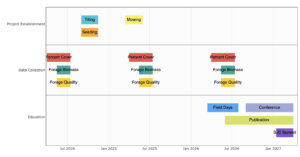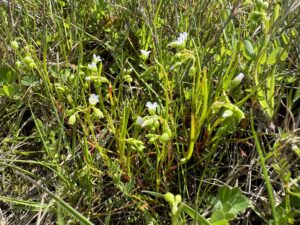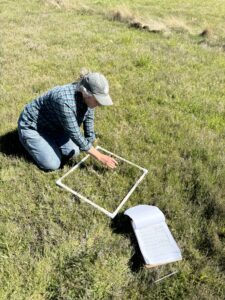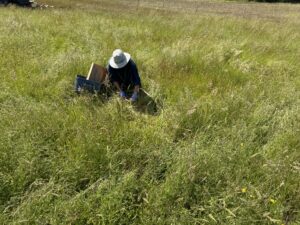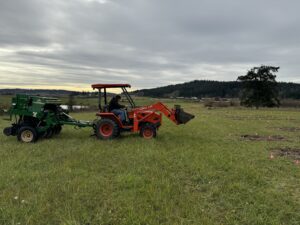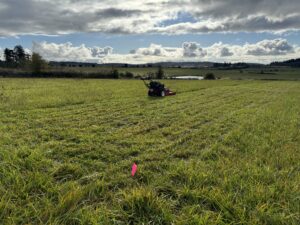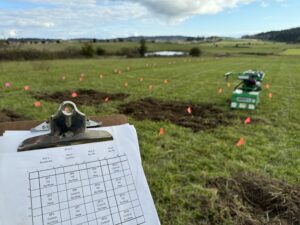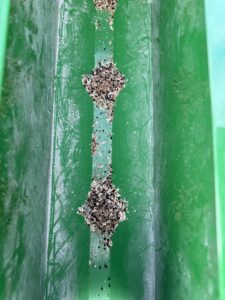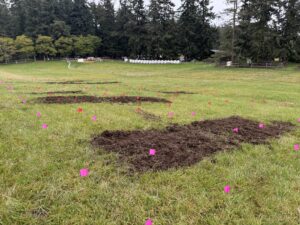Progress report for OW24-008
Project Information
The intensification of agriculture has led to the loss of habitat for pollinators. Producers using innovative strategies to meet production needs are finding ways to reduce environmental impacts. Organic production methods have reduced the use of pesticides but often do not directly address the loss of habitat for wild pollinators on which both crops and ecosystem services depend. Current efforts introducing pollinator habitat into agricultural production directly address these needs by enhancing forage production with pollinator habitat while emphasizing the social-ecological benefits of sustainable agriculture.
The proposed project explores establishing native prairie plants in grassed systems for organic producers. We seek to expand a project that began in the fall of 2022 to characterize the establishment of native forbs within the herbaceous layer of livestock forage. Farmers in western Washington state in the San Juan Islands recognize the need to conserve pollinator habitat and have demonstrated a need for technical assistance regarding regenerative pasture management and no-till methods to grow and sustain viable businesses. If funded, this project will provide evidence-based technical assistance for professionals and producers to address these needs by managing pastures for forage production and biological diversity of pollinators.
By providing education for producers, research findings from this project will help to determine best management practices available to organic farmers for the introduction of prairie plants into forage production systems. Producers will gain knowledge of appropriate methods to be able to integrate management of regenerative forage production with pollinator habitat enhancement practices.
Project objectives to characterize the establishment of native pollinator habitat using native forbs to enhance livestock forage production and provide education using our research findings:
- Test seeding methodology to determine if there is a difference in outcome between no-till and broadcast seeding;
- Test the effects of tilling during site preparation on native pollinator plant establishment;
- Test early-season mowing to determine if increased mowing in the spring over multiple years can influence forb establishment among competitive pasture grasses;
- Host field days for producers to discuss the research results informing best management practices;
- Present project findings at the San Juan County Agricultural Summit;
- Work with Master Gardeners to distribute findings via peer-to-peer educators;
- Present project results at a professional conference; and
- Publish a peer-reviewed journal article
Cooperators
- - Producer
- - Producer
- - Producer
Research
Two pasture trials were established in the fall of 2022 to investigate the capacity of organic forage production to increase native pollinator plant species. This collaborative effort began through the work of a small group of professionals and producers interested in adding pollinator habitat to farms and agricultural lands in the San Juan Islands, WA. New Hannah Farm, Catkin Design and Consulting, San Juan County Land Bank, and Washington State University San Juan County Extension (WSU SJC Extension) worked together with Natural Plant Solutions to direct seed a local native pollinator plant seed mix into pastures. The same experimental design was used to evaluate the success of site preparation and impacts on forage biomass and quality in both trial locations.
This proposal builds on the work of this small “pasture-prairie” group to expand the current scope of work and track the establishment of previously seeded pollinator plants, most of which are perennials and were not likely detected during the pilot phase of this study. If funded, this work would expand to characterize the effects of site preparation and seeding methods on forage quantity and quality. Year 1 trial data and methodologies will inform the design of this study. The seeding treatment will be modified to increase the likelihood of seeding establishment at each site. Initial trial results to date will inform seed mix selection for mesic and more xeric sites to improve overall establishment response and better inform management recommendations.
In this study, we characterize the efficacy of several factors in the establishment of native pollinator plants into pastures or hayfield and the effect of site preparation and species enrichment on forage for livestock in organic agricultural systems. Combining farmer interest in more diverse and multipurpose pastures, professional observations during previous pasture studies, and results from similar work, this project joins pasture management and pollinator habitat to assist producers in making informed decisions about livestock forage and pollinator conservation. In this study we ask:
Does the incorporation of native pollinator plants into organic livestock forage production improve native habitat for pollinators?
Null hypothesis (H0): Livestock forage production does not accommodate an increase in native plant species making up the pollinator habitat found in the herbaceous layer of the forage system.
Alternative hypothesis (H1): The incorporation of native pollinator plants into forage grasses and forbs can improve native habitat and livestock forage production.
Project Goals:
- To establish native pollinator habitat in organic pastures;
- To quantify the effect of enhancing pollinator habitat on forage biomass and quality;
- To detect a shift in pasture species composition based on management treatments; and
- To expand pollinator habitat for a rare, endangered species.
Project Objectives:
- Test seeding method to determine if there is a difference in outcome between no-till and broadcast seeding;
- Test the effects of tilling during site preparation on native pollinator plant establishment; and
- Test early-season mowing to determine if increased mowing in the spring over multiple years can influence forb establishment among competitive pasture grasses.
To address our research question, hypotheses, project goals, and objectives, we will establish two additional new pasture trials with two new producers and continue to sample previously established trials. We will continue to design and implement trials using a full-factorial randomized split-block design to test the response of native pollinator plant seedling diversity and forage productivity and quality to three treatments used as part of a strategy to enhance organic pasture with native pollinator species. These three treatments include:
- Seeding method (planting)
- Tillage (site preparation)
- Mowing (post-planting management)
Seeding treatments will be compared to determine if a difference can be determined between the the control, no-till, and broadcast treatments. We will test treatment effects to evaluate differences in terms of pollinator plant seedling establishment. No seeds will be planted in control plots, while a no-till seed drill will be used to plant seeds in no-till plots, and seeds will be broadcast by hand for broadcast treatments. Natural Plant Solutions will be contracted again to seed plots using a no-till seed drill for all trials in the study.
Site preparation will employ a tillage treatment to expose bare ground and create a seed bed for seeding native pollinator plants. This will be employed for each seeding treatments combination to test the effects of site preparation. The use of synthetic herbicides to reduce weeds is common when establishing native plant species where introduced pasture grasses are growing, but this option is not available to organic producers, so tillage represents a suitable choice for organic growers when introducing forbs into pastures. We will determine if a difference is observed when comparing a control in which no soil has been tilled and tilled subplots where a walk behind tractor has been used to turn the soil, remove weeds, and expose soil for seed contact. This will allow us to either accept or reject the null hypothesis to establish the effect of tillage on either native pollinator plant seed establishment or forage productivity in this study.
Post-planting management is incorporated into the study as a mowing treatment. This mowing treatment is used to reduce competition between the sown native plant seed mix and pre-existing, introduced pasture plants including grasses, forbs, and weeds. We will test mowing treatments to determine if there is a difference between the control and mowed subplots in terms of response of both native pollinator plant diversity and forage biomass and quality as plant biomass begins to increase during the spring and pre-existing pasture species may outcompete seeded prairie or native species for sunlight and other resources, subplots assigned to the mowing treatments will be mowed in after spring emergence of seeded pollinator plant species. This will provide native species with access to sunlight and resources to reduce the growth and use of resources by introduced pasture competitors.
We will evaluate pollinator plant species richness and the percent cover of these focal native prairie plant species at each trial location in the spring (in April). We will also estimate percent cover of functional groups during this early-season sampling date prior to flowering of grass species. During early to mid-June, when grasses are in flower and can be identified, we will return to each trial site to record plant species diversity and species percent cover for all species found in trial plots to document potential species composition change. Forage biomass will be assessed by cutting, weighing, and drying samples. Forage samples will be dried before being sent to a laboratory for forage analysis to determine a final dried weight and forage quality including crude protein, relative feed value, and neutral detergent fiber among other nutrients and feed quality index values. At the end of each spring growing season, when forage is ready to be cut for hay, the entire plot will be mowed during haying and all forage or hay removed from the trial plot.
Statistical analysis will be performed to determine the effects of trial management treatments using the R language. Data will be collected and analyzed using a split plot design with linear mixed models to accept or reject the study null hypothesis. Main and random effects will be analyzed to determine the effects of seeding and pre-and post-seeding site preparation and management. Inferences drawn from this study will allow us to determine management recommendations for farmers and agricultural specialists interested in providing pollinator habitat in pastures. This will help to fill a key gap in the San Juan Islands and help develop recommendations and best management practices to producers and landowners. Continued interest in converting pastures consisting of introduced grasses to pollinator-friendly multi-purpose pasture environments provides ample opportunity for our study results to be applied to management practices.
Research outcomes
We recommend based on our initial findings that establishment of native pollinator plants may be compatible with livestock forage production systems. These preliminary results suggest that native pollinator plants established through pasture management may result in consistent forage yields and no change or an increase in forage quality. Tillage can be important for seedling establishment (complete or nearly complete termination of grasses and forbs), and the timing of deferred mowing may also play an important role in the establishment of a suite of pollinator plants in the herbaceous layer of forage during grass and hay production.
Our findings suggest that seeding, tilling, and mowing can each contribute to positive outcomes for native pollinator species establishment in forage systems (p-values = 0.0344, 0.0428, and 0.0428 respectively). Native pollinator plants can be established using tillage without significantly impacting forage crop yields (see Table 4). We recommend that pollinator plant cover can be increased using the establishment of both perennial and annual species. In this study the perennial Allium cernuum, or nodding onion responded positively to tillage. Additionally, legumes responded positively to tillage (Table 3, p-value = 0.0003), providing indirect effects beneficial to pollinators and soil nitrogen fixation, though depending on the species of vetch, this response could be undesirable for livestock due to potential toxicity. We recommend forage analysis may be used to monitor forage quality. Relative feed value increased positively in response to tillage (Table 4, p-value = 0.0337).
No-till and broadcast seeding methods can be recommended as comparable methods for initial seedling establishment. The no-till seeding performed slightly better overall but may depend on the species. Seeding at a higher rate would likely improve seedling cover, and observations should be made to determine site suitability for species relative to soil moisture and environmental factors. Broadcast seeding may work better for some species compared to others.
Initial findings suggest that mowing may benefit annuals in grassed forage systems. The annual species Plectritis congesta in this study benefitted from an initial deferred mowing during the first spring growing season and broadcast seeding, suggesting that annuals such as Plectritis may respond well to combined mowing and broadcast seeding (Table 5). Timing of treatment combinations involving mowing around anthesis of annual species could provide future insights.
The following tables summarize findings based on field data collected during the spring of 2024 at one study site located at New Hannah Farm on San Juan Island in Washington State. This site was previously established in fall of 2022 during a pilot study. Two additional study sites were established during the 2024 grant period at Zylstra Lake on San Juan Island and Lum Farm on Orcas Island. To-date these research outcomes characterize the response of native plant species that were seeded, individual seeded species that were observed, functional diversity, forage yield, and forage quality to seeding, tilling, and mowing treatments.
Table 1. Richness and Percent Cover by Seeding
|
Observation |
Control |
No-till |
Broadcast |
p-value |
|
Target richness |
0 ± 0 |
0.31 ± 0.48 |
0.25 ± 0.45 |
0.0344* |
|
ALCE (%) |
0 ± 0 |
0.75 ± 1.69 |
0 ± 0 |
0.0536 |
|
PLCO (%) |
|
|
|
|
|
Mowing control |
0 ± 0 |
0 ± 0 |
0 ± 0 |
NA |
|
Mowing |
0 ± 0 |
0.13 ± 0.35 |
0.5 ± 0.54 |
0.0291* |
|
Grass (%) |
71.9 ± 15.5 |
71.9 ± 8.54 |
64.1 ± 15.7 |
0.1751 |
|
Forb (%) |
3 ± 3.78 |
6.25 ± 6.08 |
6.25 ± 6.08 |
0.0656 |
|
Legume (%) |
|
|
|
|
|
Mowing control |
14.8 ± 17.5 |
17.8 ± 20.3 |
31.5 ± 21.8 |
0.084 |
|
Mowing |
20 ± 23.8 |
23.9 ± 18.7 |
10.8 ± 9.27 |
0.2312 |
|
Bare (%) |
1.69 ± 1.66 |
2.94 ± 6.05 |
1.56 ± 2.53 |
0.5266 |
Table 2. Forage Yield and Quality by Seeding
|
Observation |
Control |
No-till |
Broadcast |
p-value |
|
Forage yield (lbs./acre) |
1,060 ± 283 |
1,058 ± 187 |
1,202 ± 252 |
0.123 |
|
Crude protein (%) |
7.63 ± 1.2 |
8.11 ± 2.46 |
7.43 ± 2.05 |
0.5829 |
|
RFV |
111 ± 9.14 |
117 ± 16.0 |
113 ± 8 |
0.3028 |
Table 3. Richness and Percent Cover by Tillage
|
Observation |
Control |
Till |
p-value |
|
Target richness |
0.08 ± 0.28 |
0.29 ± 0.46 |
0.0428* |
|
ALCE (%) |
0 ± 0 |
0.5 ± 1.41 |
0.0493* |
|
PLCO (%) |
0.08 ± 0.28 |
0.13 ± 0.34 |
0.5673 |
|
Grass (%) |
70.8 ± 15.9 |
67.7 ± 11.6 |
0.4224 |
|
Forb (%) |
4.21 ± 5.66 |
6.12 ± 5.34 |
0.0876 |
|
Legume (%) |
10.7 ± 12.3 |
28.8 ± 20.9 |
0.0003*** |
|
Bare (%) |
1.38 ± 2.06 |
2.75 ± 5.04 |
0.1389 |
Table 4. Forage Yield and Quality by Tillage
|
Observation |
Control |
Till |
p-value |
|
Forage yield (lbs./acre) |
1,070 ± 234 |
1,144 ± 261 |
0.37 |
|
Crude protein (%) |
7.78 ± 2.21 |
7.68 ± 1.71 |
0.8558 |
|
RFV |
111 ± 13.1 |
116 ± 9.78 |
0.0337* |
Table 5. Richness and Percent Cover by Mowing
|
Observation |
Control |
Mow |
p-value |
|
Target richness |
0.08 ± 0.28 |
0.29 ± 0.46 |
0.0428* |
|
ALCE (%) |
0.25 ± 1.03 |
0.25 ± 1.03 |
1 |
|
PLCO (%) |
|
|
|
|
Seeding control |
0 ± 0 |
0 ± 0 |
NA |
|
No-till |
0 ± 0 |
0.13 ± 0.35 |
NA |
|
Broadcast |
0 ± 0 |
0.5 ± 0.54 |
0.0152* |
|
Grass (%) |
69.8 ± 14.7 |
68.8 ± 13.3 |
0.7883 |
|
Forb (%) |
4.79 ± 5.65 |
5.54 ± 5.5 |
0.4966 |
|
Legume (%) |
|
|
|
|
Seeding control |
14.8 ± 17.5 |
20 ± 23.8 |
0.598 |
|
No-till |
17.8 ± 20.3 |
23.9 ± 18.7 |
0.4426 |
|
Broadcast |
31.5 ± 21.8 |
10.8 ± 9.27 |
0.0008*** |
|
Bare (%) |
1.46 ± 1.38 |
2.67 ± 5.29 |
0.7346 |
Table 6. Forage Yield and Quality by Mowing
|
Observation |
Control |
Mow |
p-value |
|
Forage yield (lbs./acre) |
1,088 ± 264 |
1,126 ± 235 |
0.578 |
|
Crude Protein (%) |
7.79 ± 1.85 |
7.66 ± 2.09 |
0.8085 |
|
RFV |
114 ± 10.6 |
113 ± 12.9 |
0.3928 |
Tables 1–6. Mean and standard deviation (SD) shown for each treatment combination. Significance level of statistical hypothesis testing was analyzed using p < 0.05. These results are shown for analysis of variance (ANOVA) tests for only one study site, using n = 4 replicates per treatment combination in a full-factorial blocked design with 12 main plots and 48 subplots. Target richness represents the mean number of native species of plants identified during an inventory that were seeded at the study site. Allium cernuum, or nodding onion, a perennial, is abbreviated using ALCE. Plectritis congesta, or seablush, an annual, is abbreviated PLCO. Relative feed value is shown as RFV.
Timeline of data collection and new site establishment:
4/23/2024 Surveyed native plant and functional diversity
6/21/2024 Collected biomass and estimated percent cover for all forage species
7/23/2024 Mowed field
9/25/2024 Recorded biomass dry weights and shipped to lab for analysis
10/17/2024 Mowed and tilled to prepare new site at Zylstra Lake (Oak Knoll Farm)
10/18/2024 Mowed and tilled to prepare new site at Lum Farm
11/6/2024 Seeded using no-till drill with Eric Borner at Zylstra and Lum locations
11/9/2024 Seeded using broadcast method at Lum Farm
12/13/2024 Seeded using broadcast method at Zylstra Lake
3/28/2025 Sampled soils and sent to lab for testing
Seeded native species were observed on 4/23/2024, but none of the native species were observed on 6/21/2024 when biomass was collected. Forage percent cover response to tillage did not exhibit a trend. Percent cover varied significantly by species. For example Anthoxanthum odoratum showed a higher percent cover for the control treatment compared to tillage (for the control, 14.2 mean, 8.56 standard deviation or SD; for tillage, mean equals 5.37 and SD is 9.08, and p-value < 0.0001). Vicia hirsuta showed a similar response (control mean of 45 and 29.6 SD; tillage mean 22.1, 29 SD, and p-value = 0.0048). However, Bromus commutatus (control mean 0.88 and 1.9 SD; tillage mean 9.08 and 17.1 SD, and p-value = 0.0108), Holcus lanatus (control mean 0.71 and 1.68 SD; tillage mean 3.12 and 4.28 SD, and p-value = 0.0263), and Trifolium dubium (control mean 17.5 and 23 SD; tillage mean 26.2 and 22.1 SD, and p-value <0.0001) had greater percent cover in response to tillage compared to the control.
Zylstra Lake (Oak Knoll Farm) and Lum Farm study sites, which were seeded in fall 2024, will be inventoried for target species and percent cover in spring 2025 using the same methods used at New Hannah Farm. All three sites share the same split-plot study design described above. Each design was randomized separately. Seed planted included a mix of ten native forbs were selected to plant in the trial: yarrow (Achillea millefolium), nodding onion (Allium cernuum), great camas (Camassia leichtlinii), field chickweed (Cerastium arvense), Oregon sunshine (Erophyllum lanatum), spring gold (Lomatium utriculatum), sea blush (Plectritis congesta), heal-all (Prunella vulgaris), Idaho blue-eyed grass (Sisyrinchium idahoense), and western goldenrod (Solidago lepida var salebrosa).
During 2024, the San Juan Islands Conservation District leveraged this current SARE grant, which resulted in the award of additional funding from the Washington State Conservation Commission’s Sustainable Farms and Fields grant program. This project is titled San Juan Islands Conservation District Demonstration Project: Pasture-Prairie Establishment Project and was awarded $7,000 to continue using a previously established site with the same study design, data collection, and analysis methods. This location was originally intended to be included in the application for this SARE grant. It was prepared and seeded at the same time as the site at New Hannah Farm but was ineligible for the SARE Professional + Producer grant due to lack of a farmer leasing San Juan County Land Bank property at the time.
We would like to thank all of the producers, Christine and Zack Chan of New Hannah Farm, Eric and Amy Lum of Lum Farm, and Adam Greene and Sarah Pope of Oak Knoll Farm. We would like to thank the Western SARE program and staff, Montana State University, Washington State University San Juan County Extension and Rebecca Moore, San Juan County Conservation Land Bank and Eliza Habegger, Eric Borner of Natural Plant Solutions, and Genevieve Gislason.
Education and Outreach
Participation summary:
None. No education or outreach activities were planned or carried out for year 1.
None. Please see above.
Education and Outreach Outcomes
None. No education or outreach activities were planned or carried out for year 1.
Please see above.
